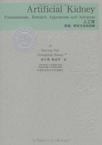人工肾
2009-6
中国科学技术大学出版社
高大勇,黄忠平 等
331
大学最重要的功能是向社会输送人才.大学对于一个国家、民族乃至世界的重要性和贡献度,很大程度上是通过毕业生在社会各领域所取得的成就来体现的.中国科学技术大学建校只有短短的50年,之所以迅速成为享有较高国际声誉的著名大学之一,主要就是因为她培养出了一大批德才兼备的优秀毕业生.他们志向高远、基础扎实、综合素质高、创新能力强,在国内外科技、经济、教育等领域做出了杰出的贡献,为中国科大赢得了“科技英才的摇篮”的美誉.2008年9月,胡锦涛总书记为中国科大建校五十周年发来贺信,信中称赞说:半个世纪以来,中国科学技术大学依托中国科学院,按照全院办校、所系结合的方针,弘扬红专并进、理实交融的校风,努力推进教学和科研工作的改革创新,为党和国家培养了一大批科技人才,取得了一系列具有世界先进水平的原创性科技成果,为推动我国科教事业发展和社会主义现代化建设做出了重要贡献.据统计,中国科大迄今已毕业的5万人中,已有42人当选中国科学院和中国工程院院士,是同期(自1963年以来)毕业生中当选院士数最多的高校之一.其中,本科毕业生中平均每1,000人就产生1名院士和。700多名硕士、博士,比例位居全国高校之首.还有众多的中青年才俊成为我国科技、企业、教育等领域的领军人物和骨干.在历年评选的“中国青年五四奖章”获得者中,作为科技界、科技创新型企业界青年才俊代表,科大毕业生已连续多年榜上有名,获奖总人数位居全国高校前列.鲜为人知的是,有数千名优秀毕业生踏上国防战线,为科技强军做出了重要贡献,涌现出20多名科技将军和一大批国防科技中坚.
本书系统介绍了人工肾的起源、结构系统、工作原理及发展前景,详细论述了多种人工肾数理模型和计算机模拟优化方法,并运用大量实例阐述了人工肾实验研究方法。本书适合生物医学工程、临床医学、血液透析、膜科学、传热传质、化工领域的学生、教师以及研究人员阅读,可作为相应课程的教学参考书及新型人工肾研发的实用手册。
Preface to the USTC Alumni's SeriesList of SymbolsSection Ⅰ Introduction Chapter 1 Human Kidneys 1.1 Function and Structure of Human Kidney 1.2 Kidney Failure 1.3 End-Stage Renal Disease 1.4 Classification of Uremic Solutes Chapter 2 Artificial Kidneys 2.1 Function and Structure of Artificial Kidney 2.2 Major Milestones of Artificial Kidney Development 2.3 Classification of Artificial Kidneys 2.4 Dialysis Membranes Chapter 3 Transport in Artificial Kidneys 3.1 Diffusive Transport 3.2 Convective Transport 3.3 Coupled Diffusive-Convective Transport ReferencesSection Ⅱ Numerical Analyses of Mass Transfer in Artificial Kidney Chapter 4 Equivalent Annulus Model 4.1 Introduction 4.2 Modeling 4.3 Numerical Algorithm 4.4 Results and Discussion 4.5 Conclusions Chapter 5 Porous Media Model 5.1 Introduction 5.2 Modeling and Algorithm 5.3 Results and Discussion 5.4 Conclusions Chapter 6 Double Porous Media Model 6.1 Introduction 6.2 Theory 6.3 Simulation Conditions 6.4 Validation of Model 6.5 Conclusions Chapter 7 Determinations of Membrane Properties and Parameters 7.1 Introduction 7.2 Preparation of Mini-Module Dialyzer 7.3 Selection of Solutes 7.4 Measurement of Hydraulic Permeability 7.5 Measurement of Diffusive Permeability 7.6 Measurement of Reflection Coefficient 7.7 Sample Assays 7.8 Calculation of Pore Size 7.9 Measurement of Darcy Permeability Chapter 8 Kinetic Modeling in Hemodialysis 8.1 Introduction 8.2 Simulation of Continuous Renal Replacement Therapy(CRRT) 8.3 Intermittent Hemodialysis and Sustained Low-EfficiencyDialysis 8.4 Results and Discussion 8.5 Conclusions ReferencesSection Ⅲ In Vitro Experimental Study of Hemodialysis Chapter 9 Introduction to General in Vitro Methodologies 9.1 Hemodialyzers and Hemofilters 9.2 Experimental Solutes 9.3 System Setup 9.4 Data Analysis Chapter 10 Local Clearance of Hemodialyzer 10.1 Introduction 10.2 Materials and Methods 10.3 Experiment Setup 10.4 Data Collection and Analysis 10.5 Results and Discussion 10.6 Conclusions Chapter 11 Effects of Dialyzer Reprocessing 11.1 Introduction 11.2 Materials and Methods 11.3 Results and Discussion 11.4 Conclusions Chapter 12 Cytokine-Induced Substance Back Transport in a High Flux Dialyzer 12.1 Introduction 12.2 Materials and Methods 12.3 Results 12.4 Discussion 12.5 Conclusions Chapter 13 A Study of Dilution Mode and Ultrafiltration Rate in a High Volume Continuous Hemofiltration 13.1 Introduction 13.2 Materials and Methods 13.3 Assays 13.4 Results 13.5 Conclusions Chapter 14 Determinants of Solute Clearance in Hemodiafiltration 14.1 Introduction 14.2 Purpose 14.3 Materials and Methods 14.4 Assays 14.5 Results and Discussion 14.6 Conclusions ReferencesSection Ⅳ Novel MRI Approach for Flow Field Measurement Chapter 15 Basic Principles of MRI 15.1 Magnetic Properties of Atomic Nuclei 15.2 Relaxation Processes 15.3 Standard Imaging Pulse Sequences 15.4 Magnetic Resonance Flow-Imaging Techniques Chapter 16 Experimental Design and Image Analysis 16.1 Flow Phantom 16.2 2-D Phase-Contrast Study 16.3 2-D Fourier-Transform Study 16.4 Results of 2-D Phase-Contrast Study 16.5 Results of 2-D Fourier-Transform Study ReferencesSection Ⅴ Advances in New Membrane Development Chapter 17 Ceramic Membrane for Hemodialysis 17.1 Introduction 17.2 Principle of Aluminum Anodization 17.3 Materials and Methods 17.4 Results and Discussion 17.5 Conclusions Chapter 18 Bio-functional Artificial Kidney 18.1 Current Status of Therapy for Renal Failure 18.2 Bioengineered KidneyReferences
插图: In addition, the mortality rate of ESRD patients in the United Statesremains higher than those reported in other industrialized nations such asEurope and Japan. Between the year 1982 and 1987, Japan had a 61%unadjusted five-year survival of ESRD patients, Europe had a 59%unadjusted five-year survival of ESRD patients, and the United Statesonly had 40% unadjusted five-year survival of ESRD patients. Whenadjusted for age and proportion of patients with diabetic nephropathy,the adjusted five-year survival of ESRD patients in the United Statesremained lower than that in Europe, followed by Japan. The adjustedrelative risk of mortality for ESRD patients in United States was 1.33compared to the ESRD patients in Japan and was 1.15 compared to theESRD patients in Europe (Held et al. 1990). It has also been reportedthat the mortality rates of ESRD patients undergoing dialysis therapy inthe United States were 25% to 50% higher than those in Japan andEurope (Friedman 1996). In the year 1991, the gross mortality rate per 100 patient-years forthe ESRD patients in the United States was 28.7 compared to 13.0 for theESRD patients in Italy who started renal replacement therapy in 1986 and1987 respectively. The unadjusted relative risk of mortality for the ESRDpatients in Italy was 0. 439 compared to those in the United States. Whenadjusted for age, gender, diabetic status, comorbid conditions, andtreatment modality; the adjusted one-year, two-year, and five-yearsurvivals for the ESRD patients in the United States were 84. 4%,67. 0%, and 33.4% respectively, and those for the ESRD patients in Italywere 88.3%, 75.9%, and 45.9% respectively. The adjusted relative riskof mortality for the ESRD patients in Italy was 29% lower than that forthe ESRD patients in the United States (Marcelli et al. 1996).
